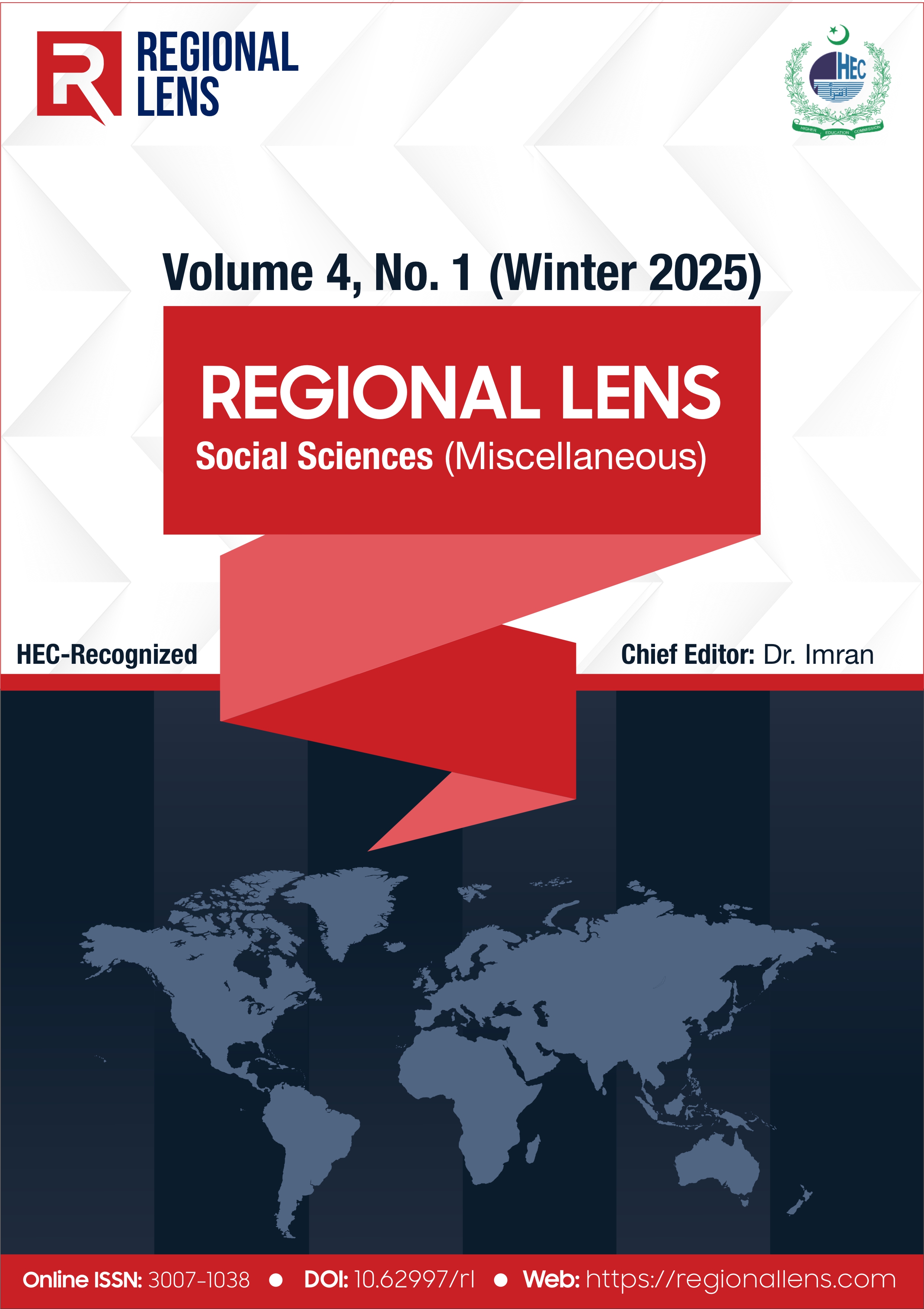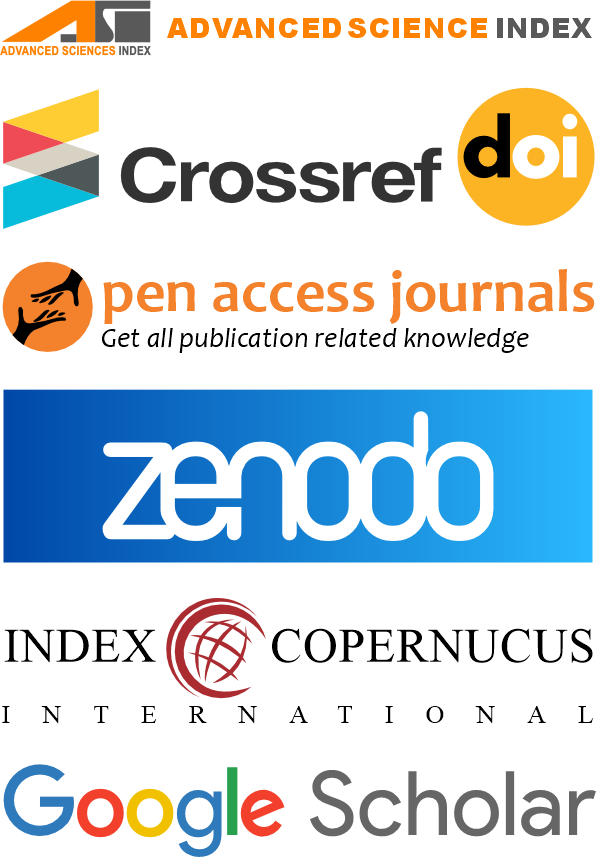Examining the Environmental Education Themes Presented in Grade 8 Social Studies Sindh Textbook Board Jamshoro, Sindh
DOI:
https://doi.org/10.62997/rl.2025.41049Keywords:
Environmental Education, Themes, Social Studies, TextbookAbstract
Environmental education is instrumental in enhancing awareness of ecological challenges, cultivating eco-literacy, encouraging environmental stewardship, and empowering youth to act. Its relevance extends globally, and numerous research studies have been conducted internationally to illuminate the consequences associated with environmental issues. For this purpose, the study examined the environmental education themes presented in social studies in the Grade 8th Sindh Textbook Board Jamshoro. The research methodology employed in this study was qualitative, utilizing content analysis as the primary method. Data collection was conducted through document analysis and Criterion Sampling, with a specific focus on a social studies textbook for eighth-grade students in Sindh, which served as the sample for this investigation. Thematic analysis was employed to systematically investigate the coded data, facilitating an exploration of the recurring themes, topics, patterns, and issues related to environmental education discourses found within the textbook. The results revealed that the textbook discusses the effects of environmental pollution on human health, migration trends, and economic activities. Population growth is a burden on resources. There exists a significant imperative to implement effective environmental initiatives and case studies aimed at motivating students. It is advisable for the state to undertake prompt actions to safeguard the environment from various forms of pollution and practices that have direct or indirect repercussions on ecological health. Furthermore, it is essential to incorporate projects and activities within social studies curricula that promote experiential learning and problem-solving competencies, thereby equipping students to effectively respond to natural disasters.
References
Ahmed, M., & Schmitz, M. (2011). Economic assessment of the impact of climate change on the agriculture of Pakistan. Business and Economic Horizons, 4(1), 1-12. https://doi.org/10.15208/beh.2011.1
Alam, S. (2017). Environmental education: Role of physical environment in Students’ learning in Gilgit-Baltistan, Pakistan. Journal of Education and Vocational Research, 8(2), 22-33. https://doi.org/10.22610/jevr.v8i2.1859
Atif, I., Ahsan Mahboob, M., & Waheed, A. (2016). Spatio-temporal mapping and multi-sector damage assessment of 2014 flood in Pakistan using remote sensing and GIS. Indian Journal of Science and Technology, 9(1). https://doi.org/10.17485/ijst/2015/v8i35/76780
Azimi, H., Mahdianpari, M., & Shiri, H. (2023). Determination of parameters affecting the estimation of iceberg draft. China Ocean Engineering, 37(1), 62-72. https://doi.org/10.1007/s13344-023-0006-6
Bengtsson, M. (2016). How to plan and perform a qualitative study using content analysis. NursingPlus Open, 2, 8-14. https://doi.org/10.1016/j.npls.2016.01.001
Bercasio, R. R. (2022). Effectiveness of "Greening" the professional education courses in teacher education program in the national network of normal schools. Randwick International of Education and Linguistics Science Journal, 3(3), 420-431. https://doi.org/10.47175/rielsj.v3i3.530
Biesta, G. (2015). What is education for? On good education, teacher judgement, and educational professionalism. European Journal of Education, 50(1), 75-87. https://doi.org/10.1111/ejed.12109
Bokhari, A. (2024). Editorial; Population Bomb Explored in Pakistan with Serious Implications (Population Growth and Demographic Dividend). Sial Journal of Medical Sciences, 2(4), 1-6. https://doi.org/10.60127/7f6nda73
Bonnett, M. (2007). Environmental education and the issue of nature. Journal of Curriculum Studies, 39(6), 707-721. https://doi.org/10.1080/00220270701447149
Busi, R., Gandipilli, G., & Kuramana, S. (2023). Elements of environmental education, curriculum and teacher’s perspective: A review. Integrated Journal for Research in Arts and Humanities, 3(6), 9-17. https://doi.org/10.55544/ijrah.3.6.2
Cockerill, K., Armstrong, M., Richter, J., & Okie, J. G. (2017). Environmental realism: challenging solutions. Springer.
Effects, W. P. (2006). In Grinning Planet, Saving the Planet One Joke at a Time.
Farooqi, A., & Fatimah, H. (2010). Historical perspective of environmental education and its objectives in Pakistan. Science, 29(1).
Feinstein, L., Sabates, R., Anderson, T. M., Sorhaindo, A., & Hammond, C. (2006, March). What are the effects of education on health? In Measuring the effects of education on health and civic engagement: Proceedings of the Copenhagen symposium (pp. 171-354). Paris, France: Organization for Economic Co-operation and Development.
Fink, S. (2003). Creating Significant Learning Experiences: An Integrated Approach to Designing College Courses. San Francisco, California: Jossey-Bass.
Foley, J. A., Ramankutty, N., Brauman, K. A., Cassidy, E. S., Gerber, J. S., Johnston, M., ... & Zaks, D. P. (2011). Solutions for a cultivated planet. Nature, 478(7369), 337-342. https://doi.org/10.1038/nature10452
Fuller, R., Landrigan, P. J., Balakrishnan, K., Bathan, G., Bose-O’Reilly, S., Brauer, M., Caravanos, J., Chiles, T., Cohen, A., Corra, L., Cropper, M., Ferraro, G., Hanna, J., Hanrahan, D., Hu, H., Hunter, D., Janata, G., Kupka, R., Lanphear, B., … Yan, C. (2022). Pollution and health: a progress update. The Lancet. Planetary Health, 6(6), e535–e547. https://doi.org/10.1016/S2542-5196(22)00090-0
Glackin, M., & King, H. (2020). Taking stock of environmental education policy in England–the what, the where, and the why. Environmental Education Research, 26(3), 305-323. https://doi.org/10.1080/13504622.2019.1707513
Glaser, R., Chudowsky, N., & Pellegrino, J. W. (Eds.). (2001). Knowing what students know: The science and design of educational assessment. National Academies Press.
Guevara, R., Whelan, J., & Flowers, R. (2009). Popular and informal environmental education: the need for more research in an" emerging" field of practice. REPORT-Zeitschrift für Weiterbildungsforschung, 32(2), 35-50. https://doi.org/10.3278/REP0902W036
HANDS (Health and Nutrition Development Society). (2014). 1st. Situation Analysis Survey-Tharparkar.
Hanif, M., & Ramey, M. A. (2014). Climate change scenarios in Pakistan, a case study of Thar Sindh. Climate Change Adaptation Project in Tharparkar. Research & Development Foundation (RDF) German Federal Ministry for Economic Cooperation & Development (BMZ) Kindernothlife (KNH).
Hassan, S., & Murtaza, M. (2012). Malaria, dynamic epidemiology in flood affected area od District Muzafar Garh, Punjab, Pakistan in 2010. International Journal of Infectious Diseases, 16, e346. https://doi.org/10.1016/j.ijid.2012.05.419
Hudson, S. J. (2001). Challenges for environmental education: Issues and ideas for the 21st century: Environmental education, a vital component of efforts to solve environmental problems, must stay relevant to the needs and interests of the community and yet constantly adapt to the rapidly changing social and technological landscape. Bioscience, 51(4), 283-288. https://doi.org/10.1641/0006-3568(2001)051[0283:cfeeia]2.0.co;2
Hungerford, H. R., & Volk, T. L. (1990). Changing learner behavior through environmental education. The Journal of Environmental Education, 21(3), 8-21. https://doi.org/10.1080/00958964.1990.10753743
Imran, M., Akhtar, S., Chen, Y., & Ahmad, S. (2021). Environmental education and women: Voices from Pakistan. Sage Open, 11(2). https://doi.org/10.1177/21582440211009469
Iyke, B. N. (2024). Climate change, energy security risk, and clean energy investment. Energy Economics, 129, 107225. https://doi.org/10.1016/j.eneco.2023.107225
Jackson, T. (2009). Prosperity without growth: Economics for a finite planet. Routledge.
Jaggarta Organization. (2014). Tharparkar drought 2014. https://reliefweb.int/sites/reliefweb.int/files/resources/Tharparkar%20Drought%202014.pdf
Jannah, M. (2023). HKI. Impact of Environmental Education Kit on Students' Environmental Literacy. IN Ar-Raniry Banda Aceh.
Klein, N. (2015). This changes everything: Capitalism vs. the climate. Simon and Schuster.
Kohlstedt, S. G. (1997). Nature study in North America and Australasia, 1890-1945: International connections and local implementations. Historical records of Australian science, 11(3), 439-454.
Li, T., Umar, M., Mirza, N., & Yue, X. G. (2023). Green financing and resources utilization: A story of N-11 economies in the climate change era. Economic Analysis and Policy, 78, 1174-1184. https://doi.org/10.1016/j.eap.2023.05.007
MOCC. http://www.mocc.gov.pk/.(2021).
Monroe, M. C., Andrews, E., & Biedenweg, K. (2008). A Framework for Environmental Education Strategies. Applied Environmental Education & Communication, 6(3–4), 205–216. https://doi.org/10.1080/15330150801944416
Nazir, N., & Ahmad, S. (2018). Forest land conversion dynamics: a case of Pakistan. Environment Development and Sustainability, 20(1), 389–405. https://doi.org/10.1007/s10668-016-9887-3
Negev, M., Garb, Y., Biller, R., Sagy, G., & Tal, A. (2009). Environmental problems, causes, and solutions: An open question. The Journal of Environmental Education, 41(2), 101–115. https://doi.org/10.1080/00958960903295258
Of, M. (2012). National Climate Change Policy Government of Pakistan.
Peckover, C. (2012). Realizing the Natural Self: Rousseau and the Current System of Education. Philosophical Studies in Education, 43, 84-94.
Rawat, A., Kumar, D., & Khati, B. S. (2024). A review on climate change impacts, models, and its consequences on different sectors: a systematic approach. Journal of Water and Climate Change, 15(1), 104-126. https://doi.org/10.2166/wcc.2023.536
Salmani, B., Hakimzadeh, R., Asgari, M., & Khaleghinezhad, S. A. (2015). Environmental Education in Iranian School Curriculum, content analyses of Social Studies and science textbooks. International Journal of Environmental Research, 9(1), 151-156.
Saminathan, Dr. B. (2016). ENVIRONMENTAL EDUCATION (Vol. 1).
Santone, S., Saunders, S., & Seguin, C. (2014). Essential elements of sustainability in teacher education. Journal of Sustainability Education, 6(5), 1-15.
Sauvé, L. (2005). Environmental education: possibilities and constraints. Educação e Pesquisa, 31, 317-322. https://doi.org/10.1590/S1517-97022005000200012
Şeker, M. (2023). A study on how environmental issues is discussed in social studies textbooks. Environment, Development and Sustainability, 1-28. https://doi.org/10.1007/s10668-023-03532-2
Sherren, K. (2006). Core issues: Reflections on sustainability in Australian university coursework programs. International Journal of Sustainability in Higher Education, 7(4), 400-413. https://doi.org/10.1108/14676370610702208
Siddiqui, S., & Safi, M. W. A. (2017). Assessing the socio-economic and environmental impacts of the 2014 drought in District Tharparkar, Sindh-Pakistan. International Journal of Economic and Environmental Geology, 8(4), 8-15.
Sindh Environmental Protection Act, 2014 (No. VIII of 2014).
Sindh Hazardous Substances Rules 2014. 2014-12-19
Slattery, D. (1999). Adult environmental education and ecology. Australian Journal of Environmental Education, 15, 85-93. https://doi.org/10.1017/S0814062600002640
Sofaer, S. (1999). Qualitative methods: what are they and why use them? Health services research, 34(5 Pt 2), 1101.
Syed, F. Z., Awan, M. W., Mushtaq, A. Q., & Kiran, I. (2022). Fighting climate change: a critical analysis of clean green Pakistan initiative of Pakistan tehreek-e-Insaf (pti). Journal of the Research Society of Pakistan, 59(1), 230
Taj, S. (2011). Assessing the Environmental Literacy of Secondary School Teachers in Punjab (Doctoral dissertation, University of the Punjab Lahore).
Varela-Losada, M., Vega-Marcote, P., Pérez-Rodríguez, U., & Álvarez-Lires, M. (2016). Going to action? A literature review on educational proposals in formal Environmental Education. Environmental Education Research, 22(3), 390-421. http://dx.doi.org/10.1080/13504622.2015.1101751
Walker, R. (1993). Deforestation and economic development. Canadian Journal of Regional Science, 16(3), 481-497. https://idjs.ca/images/rcsr/archives/V16N3-Walker.pdf
Wolfe, V. L. (2001). A survey of the environmental education of students in non‐environmental majors at four‐year institutions in the USA. International Journal of Sustainability in Higher Education, 2(4), 301-315. http://dx.doi.org/10.1108/EUM0000000006026
Yalmanci, S. G., & Gozum, A. İ. C. (2019). The study of whether receiving a pre-school education is a predictive factor in the attitudes of high school students toward the environment according to their environmental ethics approach. International Electronic Journal of Environmental Education, 9(1), 18-32.
Yeshalem, A. D. (2013). Environmental education about, in and for the environment: The case of two secondary schools in Ethiopia (master’s thesis). http://hdl.handle.net/10852/37984




